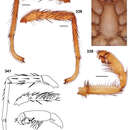Description
provided by Zookeys
Specimen preparation and condition. Specimen presumed to have been collected from pitfall trap, preserved in 70%EtOH. Coloration faded; abdomen extremely faded, collapsed. Pedipalp, leg I left/right side removed, stored in vial with specimen. General coloration. Carapace, chelicerae, legs strong brown 7.5YR 4/6. Abdomen uniform light brown 7.5YR 6/3, with mottled chevron striping. Cephalothorax. Carapace 5.31 long, 4.00 wide, generally glabrous with very light white setae intermingled with few thin black setae, stout black bristles along fringe; surface smooth, pars cephalica elevated. Fringe, posterior margin with black bristles. Foveal groove deep, strongly recurved. Eyes on low mound. AER slightly procurved, PER slightly recurved. PME, AME subequal diameter. Sternum moderately setose, STRl 3.53, STRw 1.88; very thin. Posterior sternal sigilla small, positioned marginally, not contiguous, anterior sigilla pairs very small, oval, marginal. Chelicerae with distinct anterior tooth row comprising 5 teeth, posterior margin with single row of small denticles. Palpal endites with patch of small cuspules on proximal, inner margin, labium lacks cuspules, LBw 0.77, LBl 0.19. Rastellum consists of 8 stout spines not on prominent mound. Abdomen. Setose, heavy black setae intermingled with fine black setae. Legs. Leg I: 4.80, 3.48, 4.24, 2.56, 0.00; leg IV: 5.05, 2.90. Tarsi strongly bent. Light tarsal scopulae on all legs I, II; metatarsus I with light scopula distally. Tarsus I with single, slightly staggered row of 12 trichobothria. Leg I spination pattern illustrated in Figures 337, 338, 341; TSp 32, TSr 7, TSrd 1. Tibia I long relative to femur I, distal retrolateral spine group absent (Fig. 337). Metatarsus not anteverted, lacks distinct mid–ventral mating apophysis, proximal excavation (Figs 337, 338, 341). Metatarsus, tarsus I long. Strongly bent tarsus I lightly pseudosegmented. Tarsus I lacks ventral spines. Pedipalp. Palpal tibia short, width slightly less than half length (Figs 339, 341). Retrolateral surface tibia with large spine, numerous smaller, elongate ventral spines (Figs 339, 341). Palpal bulb very short (Bl/Cl 14.50). Embolus intermediate width, very thin distally, slight curvature at midpoint, not serrated distally. PTw 0.77, PTl 1.95, Bl 0.77.
Variation (3). Cl 5.31-5.75, 5.58±0.14; Cw 4.00-4.44, 4.27±0.14; STRl 3.51-3.81, 3.62±0.10; STRw 1.88-2.28, 2.08±0.12; LBw 0.74-0.77, 0.75±0.01; LBl 0.19-0.27, 0.23±0.02; leg I: 4.80-5.06, 4.93±0.08; 3.38-3.48, 3.43±0.03; 4.00-4.31, 4.18±0.09; 2.56-3.00, 2.77±0.13; 0-0, 0±0; leg IV: 5.05-5.44, 5.21±0.12; 2.90-3.44, 3.11±0.17; PTl 1.95-2.04, 1.98±0.03; PTw 0.74-0.78, 0.76±0.01; Bl 0.77-0.81, 0.79±0.01; TSp 32-39, 34.33±2.33; TSr 7-9, 7.67±0.67; TSrd 1-1, 1±0.
- bibliographic citation
- Bond J (2012) Phylogenetic treatment and taxonomic revision of the trapdoor spider genus Aptostichus Simon (Araneae, Mygalomorphae, Euctenizidae) ZooKeys 252: 1–209
- author
- Jason E. Bond
Distribution
provided by Zookeys
Aptostichus huntington is known only from the type specimen from Fresno County, collected in a pitfall trap in September. The habitat type is characterized as Sierran Steppe, Mixed Coniferous Forest, and Alpine Meadow.
- bibliographic citation
- Bond J (2012) Phylogenetic treatment and taxonomic revision of the trapdoor spider genus Aptostichus Simon (Araneae, Mygalomorphae, Euctenizidae) ZooKeys 252: 1–209
- author
- Jason E. Bond

